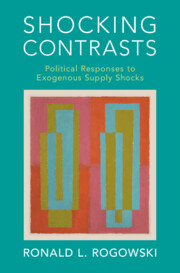Book contents
- Shocking Contrasts
- Political Economy of Institutions and Decisions
- Shocking Contrasts
- Copyright page
- Dedication
- Epigraph
- Contents
- Figures
- Maps
- Tables
- Preface and Acknowledgments
- Introduction
- 1 How Supply Shocks Arise and Why Political Responses to Them Vary
- 2 Who Adjusts to a Supply Shock and Who Resists It
- 3 Why a Technological Solution Does, or Does Not, Emerge
- 4 Exogenous Loss of Labor
- 5 Exogenous Gain of Labor: Railroads, Reproduction, and Revolution
- 6 Exogenous Loss of Land
- 7 Exogenous Increase of Human Capital
- 8 When the Endogenous Becomes Exogenous
- 9 Conclusion
- References
- Index
- Other books in the series (continued from page iii)
5 - Exogenous Gain of Labor: Railroads, Reproduction, and Revolution
The Russian Population Explosion, 1850–1914
Published online by Cambridge University Press: 09 June 2023
- Shocking Contrasts
- Political Economy of Institutions and Decisions
- Shocking Contrasts
- Copyright page
- Dedication
- Epigraph
- Contents
- Figures
- Maps
- Tables
- Preface and Acknowledgments
- Introduction
- 1 How Supply Shocks Arise and Why Political Responses to Them Vary
- 2 Who Adjusts to a Supply Shock and Who Resists It
- 3 Why a Technological Solution Does, or Does Not, Emerge
- 4 Exogenous Loss of Labor
- 5 Exogenous Gain of Labor: Railroads, Reproduction, and Revolution
- 6 Exogenous Loss of Land
- 7 Exogenous Increase of Human Capital
- 8 When the Endogenous Becomes Exogenous
- 9 Conclusion
- References
- Index
- Other books in the series (continued from page iii)
Summary
The population of Czarist Russia roughly tripled between 1850 and 1914. Keynes conjectured that this “excessive fecundity” contributed to the revolutions of 1917–18. In Russia as in contemporary India, however, population grew largely because the growing railroad network alleviated local famine. The growth and routing of the railways were determined chiefly by military considerations, hence can be regarded as exogenous. The railroads also allowed the opening of new lands and greater regional and national specialization: Russian grain exports quintupled between 1850 and 1914, foreign investment poured in, and millions of peasants moved temporarily into urban industry during months of slack farmstead demand. Hence a population explosion that would ordinarily have reduced wages and living standards was instead accompanied by rapid economic growth, per capita income almost tripling in the sixty years before 1914. The regions not serviced by railways, however, stagnated or declined; and, controlling for other factors, regional railway access correlates negatively with peasant unrest. Not rapidly growing population, but uneven development, appears most associated with rebellion.
Keywords
- Type
- Chapter
- Information
- Shocking ContrastsPolitical Responses to Exogenous Supply Shocks, pp. 83 - 103Publisher: Cambridge University PressPrint publication year: 2023



